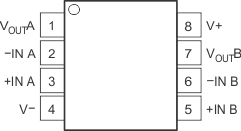SFFS799 March 2024 TLV365-Q1
4.2 SOIC Package
Figure 4-2 shows the TLVx365-Q1 pin diagram for the SOIC package. For a detailed description of the device pins, see the Pin Configuration and Functions section in the TLVx365-Q1 data sheet.
 Figure 4-2 Pin Diagram (SOIC Package)
Figure 4-2 Pin Diagram (SOIC Package)Table 4-6 Pin FMA for Device Pins
Short-Circuited to Ground
| Pin Name | Pin No. | Description of Potential Failure Effect(s) | Failure Effect Class |
|---|---|---|---|
| VOUTA | 1 | Short to GND may cause device to overheat. | B |
| -IN A | 2 | Input at V- (GND) is valid input, however, desired application result is unlikely. | C |
| +IN A | 3 | Input at V- (GND) is valid input, however, desired application result is unlikely. | C |
| V- | 4 | Normal operation, unless dual supply voltage was intended. | D |
| +IN B | 5 | Input at V- (GND) is valid input, however, desired application result is unlikely. | C |
| -IN B | 6 | Input at V- (GND) is valid input, however, desired application result is unlikely. | C |
| VOUTB | 7 | Short to GND may cause device to overheat. | B |
| V+ | 8 | Diodes from input to V+ may turn on due to input signal and cause electrical overstress (EOS). | A |
Table 4-7 Pin FMA for Device Pins
Open-Circuited
| Pin Name | Pin No. | Description of Potential Failure Effect(s) | Failure Effect Class |
|---|---|---|---|
| VOUTA | 1 | Output can be left open. There is no effect on the device, but the output will not be measured. | C |
| -IN A | 2 | Floating input, circuit will likely not function as expected. | C |
| +IN A |
3 | Floating input, circuit will likely not function as expected. | C |
| V- | 4 | Lowest voltage pin will try to power the V- pin of the device. | B |
| +IN B | 5 | Floating input, circuit will likely not function as expected. | C |
| -IN B | 6 | Floating input, circuit will likely not function as expected. | C |
| VOUTB | 7 | Output can be left open. There is no effect on the IC, but the output will not be measured. | C |
| V+ | 8 | Highest
voltage output pin will try to power the V+ pin of the device. |
B |
Table 4-8 Pin FMA for Device Pins
Short-Circuited to Adjacent Pin
| Pin Name | Pin No. | Shorted to | Description of Potential Failure Effect(s) | Failure Effect Class |
|---|---|---|---|---|
| VOUTA | 1 | -IN A | Channel 1 configured in unity gain | C |
| -IN A | 2 | +IN A | No damage to device. Application circuit will not work. | C |
| +IN A | 3 | V- | Input at V- (GND) is valid input, however, desired application result is unlikely. | C |
| V- | 4 | +IN B | Input at V- (GND) is valid input, however, desired application result is unlikely. Pins are not adjacent to each other. | C |
| +IN B | 5 | -IN B | No damage to device. Application circuit will not work | C |
| -IN B | 6 | VOUTB | Channel 2 configured in unity gain | C |
| VOUTB | 7 | V+ | Short to V+ may cause device to overheat. | B |
| V+ | 8 | VOUTA | Short to V+ may cause device to overheat. Pins are not adjacent to each other. | B |
Table 4-9 Pin FMA for Device Pins
Short-Circuited to
V+
| Pin Name | Pin No. | Description of Potential Failure Effect(s) | Failure Effect Class |
|---|---|---|---|
| VOUTA | 1 | Short to VS+ may cause device to overheat. | B |
| -IN A | 2 | Input at V+ is valid input, however, desired application result is unlikely. | C |
| +IN A | 3 | Input at V+ is a valid input, however, desired application result is unlikely. | C |
| V- | 4 | Diodes from input to V- may turn on due to input signal and cause electrical overstress (EOS). | A |
| +IN B | 5 | Input at V+ is a valid input, however, desired application result is unlikely. | C |
| -IN B | 6 | Input at V+ is a valid input, however, desired application result is unlikely. | C |
| VOUTB | 7 | Short to VS+ may cause device to overheat. | B |
| V+ | 8 | Normal Operation. | D |